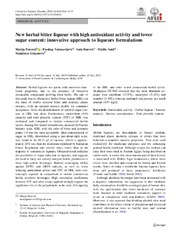Приказ основних података о документу
New herbal bitter liqueur with high antioxidant activity and lower sugar content: innovative approach to liqueurs formulations
| dc.creator | Petrović, Marija | |
| dc.creator | Vukosavljević, Predrag | |
| dc.creator | Durović, Sasa | |
| dc.creator | Antić, Mališa | |
| dc.creator | Gorjanović, Stanislava | |
| dc.date.accessioned | 2020-12-17T22:29:51Z | |
| dc.date.available | 2020-12-17T22:29:51Z | |
| dc.date.issued | 2019 | |
| dc.identifier.issn | 0022-1155 | |
| dc.identifier.uri | http://aspace.agrif.bg.ac.rs/handle/123456789/4928 | |
| dc.description.abstract | Herbal liqueurs are spirits with numerous functional properties, due to the presence of bioactive extractable compounds deriving from herbs. The aim of this study was to obtain new herbal bitter liqueur (HBL) on the basis of twelve selected bitter and aromatic plants extracts, with an optimal sensory profile for consumer acceptance. Also, the determination of optimal sugar content in HBL was done. Furthermore, antioxidant (AO) capacity and total phenolic content (TPC) of HBL was evaluated and compared to similar commercial herbal spirits. Among five tested formulations, assessed by 9-point hedonic scale, HBL with the ratio of bitter and aromatic plants 1:4 was the most acceptable. Ideal concentration of sugar in HBL, determined using a just-about-right scale, was found to be 80.32 g/l of sucrose, which is approximately 20% less than the minimum stipulated by European Union Regulation and several times lower than in the majority of commercial liqueurs. Obtained result indicates the possibility of sugar reduction in liqueurs, and suggests the need to carry out sensory analysis before production of these high-calorie beverages. Radical scavenging ability against DPPH and ABTS radicals, as well as ferric reducing antioxidant power and TPC of HBL were convincingly superior in comparison to similar commercial herbal alcoholic beverages. High correlation coefficients between TPC and other assays applied strongly support the significant role of the polyphenols in the total AO capacity of the HBL and other tested commercial herbal spirits. Headspace GC/MS revealed that the most abundant terpenes were menthone (3.75%), eucalyptol (3.42%) and menthol (3.10%), whereas methanol was present in a small amount (4.97 mg/l). | en |
| dc.publisher | Springer India, New Delhi | |
| dc.relation | info:eu-repo/grantAgreement/MESTD/Technological Development (TD or TR)/31055/RS// | |
| dc.rights | openAccess | |
| dc.source | Journal of Food Science and Technology-Mysore | |
| dc.subject | Antioxidant activity | en |
| dc.subject | Herbal liqueur | en |
| dc.subject | Sensory analysis | en |
| dc.subject | Sucrose concentration | en |
| dc.subject | Total phenolic content | en |
| dc.title | New herbal bitter liqueur with high antioxidant activity and lower sugar content: innovative approach to liqueurs formulations | en |
| dc.type | article | |
| dc.rights.license | ARR | |
| dc.citation.epage | 4473 | |
| dc.citation.issue | 10 | |
| dc.citation.other | 56(10): 4465-4473 | |
| dc.citation.rank | M22 | |
| dc.citation.spage | 4465 | |
| dc.citation.volume | 56 | |
| dc.identifier.doi | 10.1007/s13197-019-03949-6 | |
| dc.identifier.fulltext | http://aspace.agrif.bg.ac.rs/bitstream/id/3441/4925.pdf | |
| dc.identifier.scopus | 2-s2.0-85069437372 | |
| dc.identifier.pmid | 31686678 | |
| dc.identifier.wos | 000491079000008 | |
| dc.type.version | publishedVersion |


